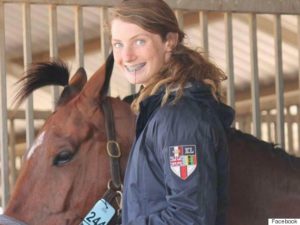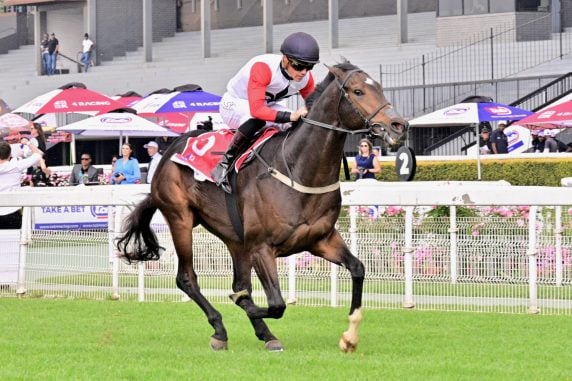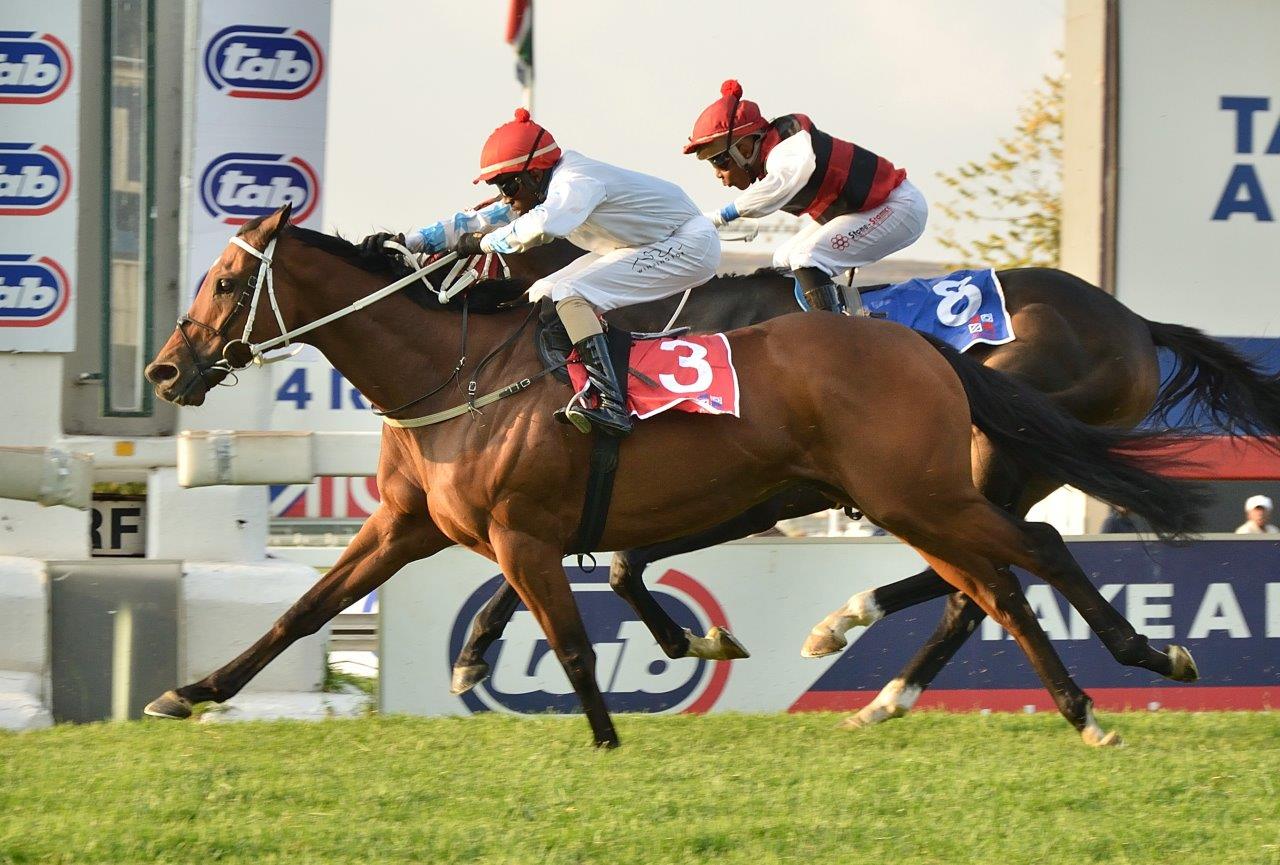After the tragedy, fellow horsewoman Lisa Purcell, whose son Tyson rides and had competed against Inglis, took action. She said “You never really know what to say, or what to do, and you feel like you want to help. We heard the news quite quickly after it happened, and I said to my son on the phone, ‘Well, when you ride Bella tomorrow you should ride for Olivia.’ And I just sort of said it. And later that night he said, ‘Well, that would be a really good hashtag.’ ” With permission from the Inglis family, Purcell appealed to the equestrian community to post photographs of themselves and their horses doing what they loved best, using the hashtag #RideForOlivia. They hoped to collect a few hundred photos to make a commemorative mosaic of Olivia, but were overwhelmed by the response. The campaign went viral, with over 8 million equestrians from every discipline all across the world posting photos and sending messages of support in the first 3 days after the tragedy. The Inglis family are creating a scholarship in Olivia’s memory, the Olivia Inglis Eventing Scholarship, which will be dedicated to seeing young riders achieve success. It was magical and uplifting to watch such a tragedy be used for so much good.
Family
Purcell commented, “I think everyone just wanted to feel a part of it and do their bit, and it’s spread beyond eventing. I think anyone who owns a horse wants to be a part of it, from show jumping, to dressage, to western, to cutting, to barrel racing, vaulting. It’s so amazing to see some of the world’s best, like Charlotte Dujardin and William Fox-Pitt post it, too. I think the equestrian community, it’s actually a family. Even if you don’t know each other.” The final product was unveiled on Monday, 14 March 2016, the day Olivia was laid to rest and whether it was used, or anyone ever acknowledges its existence, I’m proud to have contributed a photo. Because as part of the equestrian community, I’m family too and thanks to Lisa’s hashtag, we’ve seen just how extensive that family is.
If it’s not too soon to say so, I think the hashtag has come to mean so much more than ‘just’ (if that could ever be possible) a tribute to a wonderful, promising young girl, taken far too soon. #RideForOlivia has become a symbol of all that is good and precious and worth being a part of.
Which brings me to my next point. Like Olivia’s accident, it doesn’t start in a good place, but hopefully, through the hard work and efforts of a lot of people, it may yet have a positive outcome.
You can choose your friends
As Purcell commented, the equestrian community is like a family and I have often made the same observation about racing. Of course, as the old saying goes, you can’t choose your family, but the great thing about racing is that we can. There is an application process. Granted, it’s not as intensive as it once was (and perhaps more’s the pity), but there is at least a form to be filled in. The fact that there is a form and that one has to actively apply for membership implies that there is a chance that one may not be accepted. I’m not sure how often anyone gets turned away these days, but for the first time in what feels like a long time, racing is actually taking something of a stand and putting up some barriers to entry and I think that’s great.
 You see, I don’t want to be associated with asshats. I (and hopefully the rest of us) want to be associated with racing for all the noble and romantic reasons that make artists put brush to canvas, pen sonnets, break into song or whatever it is that artists do when the muse visits. At its best, racing is a great and glorious sport, populated by great and glorious animals and the people who love them. Of course, there is always that other side and there is always that pesky minority that poisons the well for the majority. You only have to open a paper or fire up your web browser to be confronted by stories where racing is made out to be cruel and exploitative (if we’re lucky). Some stories are far worse. That kind of dirt sticks and it smears off on everyone associated with it. That’s not a community I want any part of and I don’t think anyone else wants to either. And finally, it seems, the NHA is making rules to try and prevent exactly just that.
You see, I don’t want to be associated with asshats. I (and hopefully the rest of us) want to be associated with racing for all the noble and romantic reasons that make artists put brush to canvas, pen sonnets, break into song or whatever it is that artists do when the muse visits. At its best, racing is a great and glorious sport, populated by great and glorious animals and the people who love them. Of course, there is always that other side and there is always that pesky minority that poisons the well for the majority. You only have to open a paper or fire up your web browser to be confronted by stories where racing is made out to be cruel and exploitative (if we’re lucky). Some stories are far worse. That kind of dirt sticks and it smears off on everyone associated with it. That’s not a community I want any part of and I don’t think anyone else wants to either. And finally, it seems, the NHA is making rules to try and prevent exactly just that.
Racehorse Retirement Rules
 I’m talking about the recently announced racehorse retirement rules. The new rules were promulgated (which, if anyone else is wondering, means “to make known by open declaration; publish; proclaim formally or put into operation”) on 11 March 2016 and are an amendment to the existing Rule 41.7. In practice it means that the NHA is implementing rules to govern what happens to horses when they leave the track. Or if not to govern exactly, then at least to ‘guide’ owners in making their decision (this is South Africa – rules are guidelines, right?)
I’m talking about the recently announced racehorse retirement rules. The new rules were promulgated (which, if anyone else is wondering, means “to make known by open declaration; publish; proclaim formally or put into operation”) on 11 March 2016 and are an amendment to the existing Rule 41.7. In practice it means that the NHA is implementing rules to govern what happens to horses when they leave the track. Or if not to govern exactly, then at least to ‘guide’ owners in making their decision (this is South Africa – rules are guidelines, right?)
The new rule stipulates that ‘all Owners have a responsibility towards their horses, whether they have been successful or unsuccessful, and that Owners have certain obligations to make sure that their horses do not end up in unpleasant conditions.’ I like to think of it as the ‘asshat rule’ (as in, try not to be one).
The new rule comes into effect on 20 March this year and states that the owner of a racehorse will remain responsible for that horse for the rest of its life unless the horse’s ownership is transferred to another owner or an owner in another racing jurisdiction (eg if the horse is sold abroad), to a stud, to the local Horse Care Unit (with the required fee), the horse is euthanased (and reported to the NHA) or the horse is sold at an auction approved by the NHA’s Chief Executive (I suppose that will shortly be the newly appointed Lyndon Barends, but that information may well be out of date by the time this goes to print – they really should just have done with it and install a revolving door to that office). Lastly, the horse may be disposed of out of racing on condition that a “second career assessment form” has been completed by a vet, the owner and the trainer. There’s also the rather sensible directive that if necessary a horse’s medical history should be supplied in order to complete the form and a copy needs to be submitted to the Chief Executive within a week of a horse retiring from racing.
Business or pleasure
Racing likes to advertise itself as a business. I’m not sure I agree with that label entirely, but it’s one we like to use from time to time. Any business knows that PR and marketing can make or break you – ask Coca Cola. Or Penny Sparrow. Racing conducts its business in the public eye, so if we want to survive, we have to get it right. While life in the racing spotlight has been getting increasingly uncomfortable, for the first time in what seems like a very long time, we have implemented some rules that say ‘hey, we’re not prepared to put up with asshats. And anyone behaving like an asshat will be dealt with.’ If this carries on and someone actually enforces the rule, I might seriously consider reapplying.
A Better Future
In its statement, the NHA says “The National Horseracing Authority firmly believes that all racehorses deserve to be treated with care and dignity when their racing career comes to an end. Thoroughbred horses are refined athletes and do excel in other equine sports such as polo, show jumping, dressage and equitation. However, they are not designed to withstand meagre or rural conditions and every effort must be made to prevent Thoroughbreds from ending up in circumstances where they would be neglected or abused.”
Paul Simon sang that there are 50 ways to leave your lover, and Kulula added ‘but only one way off this plane’. Unfortunately in the case of a racehorse at the end of its racing career, there is also only one person who can decide it’s future. And that person’s name is in the box under ‘owner’.
There are lots of good homes out there. But let me also say that there are some that would comfortably feature in Dante’s nine circles of hell. I like to think I surround myself with good, kind, caring people but even so, I have seen things that would make your hair curl. Seriously. A sleek, shiny racehorse can be reduced to a bruised, broken, bloody hat-rack in a matter of a few weeks and if there are people out there doubting that fact, please email me and I’d be glad to furnish you with photographic evidence. It is not something you’ll forget in a hurry. And yet, when I warn yet another owner to be careful placing a horse because of the potential repercussions (and cite a few examples), I still get incredulous responses. Which means the point has not been hammered home firmly enough. So I’ll try again.
The bald facts
With the arrival of Warmbloods and other purpose bred competition horses, the slice of the leisure industry pie for Off The Track Thoroughbreds (OTTBs) has got substantially smaller. There is still a market for the good ones, but it’s not what it used to be and trust me when I say there are simply not enough happy endings to go around. A Thoroughbred is purpose-bred, raised and conditioned (mentally and physically) to be a high performance, professional athlete. And that’s fine. As long as it is confined to the sort of environment it was designed to operate in. The problem comes when you take something designed for a professional and put it in the hands of someone who isn’t.
Here’s the deal. There aren’t vast numbers of professional competition riders in South Africa and the majority of serious professionals opt for a Sport Horse of some description. So of the second home options left open to Thoroughbreds, the vast majority of those will be with amateur riders. This is fine and there are lots of ammies who are perfectly capable of retraining a Thoroughbred, but there are plenty that aren’t. Expecting things to work when the odds are clearly stacked against success is not only asking for trouble, it’s generally what causes the train wrecks we see splashed across the front pages of newspapers in the first place. So clearly the historic ‘hope and pray’ approach is not working.
The answer?
The new rule comes into effect on 20 March 2016. Do I think it is going to solve the problem? No, I don’t. At least not in its current format, although I’m not sure we’ll ever have a satisfactory ‘one stop’ solution, nor should we expect one. We will only have a viable solution when each and every one of us does our bit in making responsible decisions in retiring our horses. The answer doesn’t lie in creating rules, it lies in education, so what I think we have here is a good start, but if we all contribute, have our say and do our bit, it can go a jolly long way to making a difference. And an industry that is prepared to stand up for the welfare of its horses is something I’d be proud to be part of.










